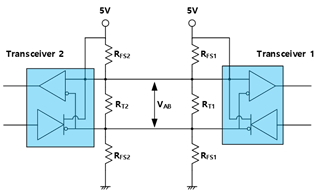Hello,
I inquire about fail safe resistors, VAB and nUL, which is the ratio of the common-mode resistance of one unit load to the common-mode resistance of the transceiver unit load.
Currently, we are using the RS-485 communication circuit as follows.

One-to-one communication is applied, and the RFS and RT values of each transceiver are as follows.
|
|
RFS |
RT |
VAB |
|
Transceiver 2 |
500Ω |
120Ω |
0.464V |
|
Transceiver 1 |
620Ω |
120Ω |
Transceiver 1 uses the MAX491 and Transceiver 2 uses the SN65176B.
When the circuit is configured as above, the VAB voltage is output over 400mV.
When the fail safe resistor is equalized, RFS = RF1 // RFS2 < 375Ω, which is lower than the RCM voltage, and the maximum number of transceiver, n, has a negative value.
※ www.edn.com/.../
* equation 7
There are my Questions,
Q1. What kind of problem occurs when the VAB voltage value in idle state is output over 400mV?
Q2. What happens when the value of n (Maximum number of transceiver) is negative? Is it okay if the value of n is negative?
Best Regards

